
- Home
- Travel Packages
- Top Destination
-
Travel Attraction
By Category
Top Attraction

- Travel Agents
- Car Rentals
- Hotels
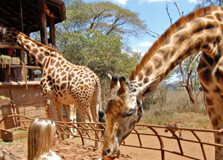
About The Giraffe Centre The Giraffe Centre, located in Lang'ata, Nairobi, is a sanctuary dedicated to the conservation and protection of the endangered Rothschild giraffe. Established in 1979, the center's primary aim is to educate the public about the importance of wildlife conservation and to breed these magnificent animals in a protected environment. The Giraffe Centre provides a unique opportunity for visitors to get up close and personal with giraffes, allowing them to feed, interact, and even receive a friendly kiss from these gentle giants. It's an educational experience that combines fun and learning, making it a popular destination for both locals and tourists. The center plays a crucial role in the preservation of Rothschild giraffes, whose population had dwindled to fewer than 120 in the wild. Through breeding programs and conservation efforts, the Giraffe Centre has successfully increased their numbers and reintroduced them into various national parks in Kenya. Additionally, the center runs extensive educational programs for schoolchildren, teaching them about environmental conservation and the importance of biodiversity. This makes the Giraffe Centre not just a tourist attraction, but a vital part of Kenya’s conservation efforts. History Of Giraffe Centre The Giraffe Centre was founded by Betty and Jock Leslie-Melville, a Kenyan-born British couple, in 1979. The couple started the center after they rescued a baby Rothschild giraffe named Daisy from western Kenya, where its natural habitat was being threatened by human activities. They brought Daisy to their home in Lang'ata and soon realized the need for a dedicated sanctuary to protect the dwindling population of Rothschild giraffes. Over the years, the Giraffe Centre has grown from a small sanctuary to a renowned conservation and education center. The African Fund for Endangered Wildlife (AFEW) Kenya, a non-profit organization established by the Leslie-Melvilles, oversees the operations of the Giraffe Centre. Through their efforts, the center has successfully bred numerous giraffes and released them into safe, protected areas across Kenya. The Giraffe Centre continues to honor the legacy of its founders by maintaining its commitment to wildlife conservation and education. Time To Visit The best time to visit the Giraffe Centre is during the dry seasons, which typically run from June to October and January to February. During these months, the weather is more favorable for outdoor activities, and the giraffes are more active. The center is open daily from 9:00 AM to 5:00 PM, including weekends and public holidays. Morning visits are recommended for a more intimate experience with the giraffes, as the center can become crowded later in the day. Entry Fee The entry fee for the Giraffe Centre is relatively affordable, making it accessible to a wide range of visitors. As of 2024, the entry fees are as follows: 1: Adults: KES 1,500 (approximately USD 15)2: Children (3-12 years): KES 750 (approximately USD 7.50)3: Children under 3 years: FreeThese fees help support the center’s conservation and education programs, ensuring the continued protection of the Rothschild giraffe and other wildlife. Time Required For Travel A visit to the Giraffe Centre typically requires around 2 to 3 hours. This time frame allows visitors to fully enjoy feeding the giraffes, exploring the nature trail, and learning from the educational exhibits. For those traveling from Nairobi's city center, the journey to the Giraffe Centre takes about 30 to 45 minutes by car, depending on traffic conditions.
Explore More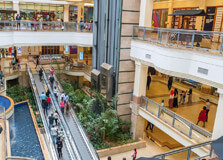
Westgate Shopping Mall About The Westgate Shopping Mall The Westgate Shopping Mall in Nairobi, Kenya, stands as a premier destination for shopping, dining, and entertainment, offering visitors a world-class retail experience in the heart of the city. Boasting a sophisticated design, modern amenities, and a diverse array of stores and eateries, Westgate Mall is a favorite among locals and tourists alike. Whether you're in search of high-end fashion, gourmet cuisine, or family-friendly activities, this iconic shopping center has something for everyone to enjoy. History of Westgate Shopping Mall Opened in 2007, the Westgate Shopping Mall quickly established itself as a landmark destination in Nairobi's bustling Westlands neighborhood. Designed to cater to the needs and preferences of discerning shoppers, the mall has undergone several expansions and renovations over the years, enhancing its offerings and amenities. Despite facing challenges such as a devastating terrorist attack in 2013, Westgate Mall has emerged stronger than ever, reaffirming its status as a premier shopping and entertainment destination in Kenya. Time to Visit Westgate Shopping Mall welcomes visitors throughout the year, providing a convenient and accessible venue for retail therapy, dining, and leisure activities. Whether you're planning a weekday shopping excursion or a weekend outing with family and friends, the mall offers extended operating hours to accommodate varying schedules. Additionally, special events, promotions, and entertainment programs are frequently held at the mall, ensuring there's always something exciting happening for visitors to enjoy. Entry Fee Admission to Westgate Shopping Mall is free of charge, allowing visitors to explore its diverse range of stores, restaurants, and entertainment options without any financial barrier. Parking fees may apply for those arriving by car, but rates are typically reasonable and based on the duration of stay. With its accessible location and welcoming atmosphere, Westgate Mall invites shoppers of all ages and backgrounds to indulge in a world-class retail experience. Time Required for Travel Traveling to Westgate Shopping Mall is convenient and straightforward, thanks to its central location in Nairobi's Westlands area. The mall is easily accessible by car, taxi, or public transportation, with ample parking available onsite for those driving. The travel time may vary depending on your starting point within Nairobi, but most visitors can expect to reach the mall within 30 to 45 minutes. Once there, plan to spend at least a few hours exploring the mall's numerous stores, dining options, and entertainment facilities, although shoppers with specific interests or preferences may choose to extend their visit accordingly. Traveling Tips Before visiting Westgate Shopping Mall, it's advisable to check the mall's website or social media channels for any updates on operating hours, special promotions, or events. Arrive early to avoid crowds and secure a convenient parking spot, especially during peak shopping hours or weekends. Wear comfortable clothing and footwear suitable for walking, as you'll likely be exploring the mall's expansive premises for an extended period. Consider bringing along a reusable shopping bag to carry your purchases and minimize environmental impact. Lastly, take advantage of the mall's amenities, including rest areas, restrooms, and baby changing facilities, to ensure a comfortable and enjoyable shopping experience for you and your companions.
Explore More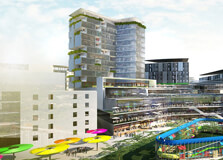
Two Rivers Mall About The Two Rivers Mall The Two Rivers Mall, located in Nairobi, Kenya, stands as one of the largest and most modern shopping and entertainment complexes in East Africa. Spanning over 65,000 square meters, this sprawling mall offers a diverse range of retail stores, dining options, leisure facilities, and entertainment venues, making it a one-stop destination for shoppers and families alike. With its contemporary design, state-of-the-art amenities, and vibrant atmosphere, Two Rivers Mall has become a popular gathering place for locals and tourists seeking world-class shopping, dining, and entertainment experiences in Nairobi. History of Two Rivers Mall Opened in 2017, Two Rivers Mall quickly made a name for itself as a premier shopping and lifestyle destination in Nairobi. Developed by the Centum Investment Company PLC, in partnership with international investors, the mall was designed to cater to the growing demand for modern retail and entertainment facilities in the region. Its strategic location along Limuru Road, near the affluent neighborhoods of Runda and Gigiri, further enhanced its appeal to shoppers and visitors from across Nairobi and beyond. Time to Visit Two Rivers Mall welcomes visitors seven days a week, providing ample opportunities for shopping, dining, and entertainment throughout the year. The mall's operating hours are typically from 10:00 AM to 8:00 PM, although individual store and restaurant hours may vary. Weekdays tend to be less crowded, making it an ideal time for leisurely shopping and dining experiences, while weekends often feature special events, promotions, and entertainment programs for visitors to enjoy. Entry Fee Admission to Two Rivers Mall is free of charge, allowing visitors to explore its vast array of retail and entertainment offerings without any financial barrier. Parking fees may apply for those arriving by car, with rates based on the duration of stay. However, the mall offers ample parking space for both regular and VIP customers, ensuring a hassle-free experience for shoppers and visitors. Time Required for Travel Traveling to Two Rivers Mall is convenient and straightforward, thanks to its prime location along Limuru Road, just a short distance from Nairobi's city center. The mall is easily accessible by car, taxi, or public transportation, with dedicated drop-off and pick-up points for added convenience. The travel time may vary depending on your starting point within Nairobi, but most visitors can expect to reach the mall within 30 to 45 minutes. Once there, plan to spend several hours exploring the mall's extensive retail, dining, and entertainment options, as well as its outdoor recreational areas and landscaped gardens. Traveling Tips Before visiting Two Rivers Mall, it's advisable to check the mall's website or social media channels for any updates on operating hours, special promotions, or events. Arrive early to secure a parking spot close to the mall entrance, especially during peak shopping hours or weekends. Wear comfortable clothing and footwear suitable for walking, as you'll likely be exploring the mall's expansive premises for an extended period.
Explore More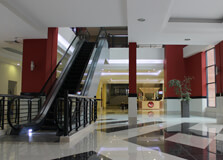
About The Lavington Mall Lavington Mall, located in the upscale Lavington neighborhood of Nairobi, Kenya, is a vibrant shopping and entertainment destination that caters to the needs and tastes of discerning shoppers and families. Boasting a modern design, spacious interiors, and a diverse mix of retail stores, restaurants, cafes, and entertainment venues, Lavington Mall offers visitors a premium shopping experience in a convenient and stylish setting. Whether you're in search of fashion-forward clothing, gourmet cuisine, or leisure activities, this mall has something for everyone to enjoy. Lavington Mall Lavington Mall is more than just a shopping center; it's a social hub where friends and families come together to shop, dine, and unwind. With its wide range of amenities and services, including ample parking, free Wi-Fi, and wheelchair accessibility, the mall strives to provide a comfortable and enjoyable experience for all visitors. From international brands and local boutiques to specialty stores and beauty salons, Lavington Mall offers a diverse array of options to suit every taste and budget. Time to Visit Lavington Mall is open daily, providing visitors with ample opportunities to explore its offerings and enjoy its amenities. The mall's operating hours typically range from 9:00 AM to 8:00 PM, although individual store and restaurant hours may vary. Weekdays tend to be less crowded, making it an ideal time for leisurely shopping and dining experiences, while weekends often feature special events, promotions, and entertainment programs for added excitement. Entry Fee There is no entry fee to access Lavington Mall, making it accessible to visitors of all ages and backgrounds. Whether you're a local resident or a tourist exploring Nairobi, the mall welcomes everyone to shop, dine, and socialize without any financial barrier. However, visitors may need to pay for parking if arriving by car, with rates typically based on the duration of stay and any applicable discounts or validations. Time Required for Travel Traveling to Lavington Mall is convenient, as it is centrally located in Nairobi's Lavington neighborhood, just a short distance from major residential areas and business districts. The mall is easily accessible by car, taxi, or public transportation, with designated drop-off points and ample parking available for those driving. The travel time may vary depending on your starting point within Nairobi, but most visitors can reach the mall within 15 to 30 minutes. Once there, plan to spend at least a few hours exploring the mall's various stores, dining options, and entertainment facilities, although you may choose to extend your visit for a full day of shopping and leisure. Traveling Tips Before visiting Lavington Mall, it's advisable to check the mall's website or social media channels for any updates on operating hours, promotions, or events. Arrive early to secure a parking spot close to the mall entrance, especially during peak shopping hours or weekends. Wear comfortable clothing and footwear suitable for walking, as you'll likely be exploring the mall's expansive premises for an extended period. Consider bringing along a reusable shopping bag to carry your purchases and minimize environmental impact. Lastly, take advantage of the mall's amenities, including rest areas, restrooms, and baby changing facilities, to ensure a comfortable and enjoyable shopping experience for you and your companions.
Explore More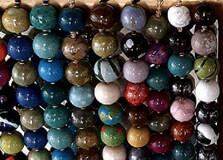
About The Kazuri Beads Factory Tour The Kazuri Beads Factory Tour offers visitors a fascinating glimpse into the world of handcrafted ceramic beads and pottery, while also providing insight into the empowering story behind this unique social enterprise. Located in Nairobi, Kenya, Kazuri Beads is renowned for its beautiful, high-quality beads and ceramics, all of which are meticulously crafted by local artisans, many of whom are single mothers from disadvantaged backgrounds. By taking a tour of the Kazuri Beads Factory, visitors not only have the opportunity to witness the intricate bead-making process firsthand but also to learn about the company's commitment to creating sustainable employment opportunities for women and supporting the local community. Kazuri Beads Factory Tour The Kazuri Beads Factory Tour offers a behind-the-scenes look at the entire bead-making process, from the shaping and painting of raw clay to the final firing and glazing of finished beads and pottery. Visitors are guided through the various stages of production by knowledgeable staff who share insights into the history of Kazuri Beads, its founder's vision, and the impact of the company's social enterprise model on the lives of its employees and their families. The tour culminates in a visit to the Kazuri Beads showroom, where visitors can browse and purchase a wide range of handmade beads, jewelry, and ceramics, knowing that their purchases support a worthy cause. Time to Visit The Kazuri Beads Factory Tour is available year-round, with tours typically conducted during weekday business hours to coincide with the factory's production schedule. The best time to visit is during the morning or early afternoon, when production is in full swing, and visitors can observe artisans at work. However, visitors are advised to book their tours in advance to ensure availability and avoid disappointment, especially during peak tourist seasons. Entry Fee There is a nominal entry fee for the Kazuri Beads Factory Tour, which helps support the factory's operations and contributes to its social impact initiatives. The fee may vary depending on the type of tour selected and any additional amenities or services offered, such as guided tours, demonstrations, or hands-on workshops. Visitors are encouraged to inquire about pricing and payment options when booking their tours. Time Required for Travel Traveling to the Kazuri Beads Factory from Nairobi's city center is relatively easy, as it is located just a short distance away in the Karen suburb. The factory is easily accessible by car, taxi, or public transportation, with designated parking available for those driving. The travel time may vary depending on your starting point within Nairobi, but most visitors can reach the factory within 30 to 45 minutes. Once there, plan to spend at least an hour or two exploring the factory and showroom, although you may choose to extend your visit to participate in additional activities or shopping. Traveling Tips Before embarking on the Kazuri Beads Factory Tour, it's advisable to dress comfortably and wear closed-toe shoes suitable for walking. Bring along a camera or smartphone to capture the sights and sounds of the factory, but be respectful of the artisans' privacy and ask permission before taking photos. Consider purchasing souvenirs or gifts from the Kazuri Beads showroom to support the company's social impact initiatives and take home a piece of Kenyan craftsmanship. Above all, approach the tour with an open mind and a sense of curiosity, and be prepared to be inspired by the creativity and resilience of the artisans behind Kazuri Beads.
Explore More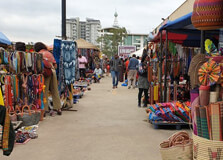
Maasai Market About The Maasai Market The Maasai Market is a vibrant and bustling open-air market in Nairobi, Kenya, renowned for its colorful array of traditional crafts, artifacts, and souvenirs. Originating from the Maasai community, one of Kenya's most iconic ethnic groups, the market offers visitors a unique opportunity to experience the rich cultural heritage and artistic traditions of the Maasai people. From beaded jewelry and woven textiles to carved wooden sculptures and leather goods, the Maasai Market showcases the finest handcrafted items made by local artisans, each piece telling a story of craftsmanship, creativity, and cultural identity. Whether you're searching for authentic Kenyan keepsakes, decorative home furnishings, or unique gifts to take home, the Maasai Market is a treasure trove of artisanal delights, where every purchase directly supports the livelihoods of the vendors and their families. Maasai Market The Maasai Market operates at various locations throughout Nairobi, with different venues hosting the market on different days of the week. While the largest and most well-known Maasai Market is held at the Village Market shopping mall on Fridays, smaller markets can be found at other locations such as the Nairobi CBD, the High Court parking lot, and the Prestige Plaza shopping mall on different days of the week. Regardless of the location, each Maasai Market offers a similar selection of handcrafted goods and provides a vibrant and colorful shopping experience that is uniquely Kenyan.
Explore More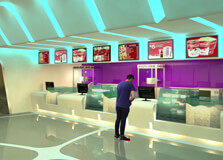
About Nyali Cinemax Nyali Cinemax, located in Mombasa, Kenya, stands as a prominent entertainment destination offering a premier cinematic experience. Situated in the vibrant Nyali neighborhood, it caters to both locals and tourists seeking top-tier movie screenings amidst modern amenities. The multiplex is celebrated for its state-of-the-art facilities, comfortable seating arrangements, and a diverse range of films spanning various genres from international blockbusters to local productions. With multiple screens equipped with the latest in audiovisual technology, Nyali Cinemax ensures an immersive and enjoyable movie-watching experience for all patrons. History of Nyali Cinemax Nyali Cinemax has a rich history dating back to its establishment as a pioneering cinema in the coastal city of Mombasa. Over the years, it has evolved into a symbol of entertainment excellence, keeping pace with technological advancements in the film industry. Originally conceived to meet the growing demand for quality movie theaters in the region, Nyali Cinemax has consistently upgraded its facilities to offer superior viewing experiences. Its strategic location in Nyali has also contributed to its popularity among locals and visitors alike, making it a preferred venue for film enthusiasts seeking both mainstream and niche cinematic offerings. Time to Visit Nyali Cinemax operates throughout the week, with screenings typically starting in the afternoon and continuing late into the evening. The best time to visit depends on personal preference, but evenings are particularly popular for catching the latest releases in a bustling and lively atmosphere. Entry Fee The entry fee at Nyali Cinemax varies based on factors such as the time of day, the type of movie, and seating preferences. Generally, ticket prices are competitive and affordable, offering value for money considering the quality of the facilities and the entertainment provided. Time Required for Travel The travel time to Nyali Cinemax depends on the starting point within Mombasa. From the city center, it typically takes around 20 to 30 minutes by car, depending on traffic conditions. Visitors are advised to plan their journey accordingly to ensure punctuality for screenings or to account for potential delays during peak hours. Traveling Tips For those planning a visit to Nyali Cinemax, here are some useful tips: Booking Tickets: It's advisable to book tickets in advance, especially for popular movies or during weekends, to secure preferred seating and avoid disappointment. Arrival Time: Arriving at least 20-30 minutes before the screening time allows for ticket collection, snack purchases, and settling comfortably into the auditorium. Parking: Nyali Cinemax provides ample parking space, but it can fill up quickly during peak hours. Arriving early ensures finding a convenient parking spot. Snacks and Refreshments: While the cinema offers a variety of snacks and beverages, some patrons prefer bringing their own. Checking the cinema's policies on outside food is recommended. Local Surroundings: Nyali neighborhood offers a range of dining and leisure options. Visitors can extend their outing by exploring nearby restaurants or shopping centers before or after the movie. Nyali Cinemax continues to be a beacon of cinematic entertainment in Mombasa, combining convenience, comfort, and quality to cater to diverse audience preferences. Whether visiting for a blockbuster premiere or a cultural film showcase, patrons can expect a memorable experience at this renowned multiplex in the heart of Nyali.
Explore More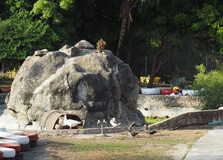
About The Mombasa Go Kart Mombasa Go Kart is a premier entertainment destination located in Mombasa, Kenya, offering a unique and thrilling experience for both locals and tourists. It is widely recognized for its state-of-the-art go-karting track, which provides an exciting and safe environment for racing enthusiasts of all ages. The facility is equipped with high-performance go-karts and a meticulously designed track that challenges drivers with various turns and straightaways. In addition to go-karting, Mombasa Go Kart offers a range of activities, including paintball, an off-road track for quad bikes, a children’s playground, and a restaurant with a panoramic view of the racing track. This makes it an ideal spot for family outings, corporate events, and group gatherings, ensuring a fun-filled day for everyone. The go-karting track at Mombasa Go Kart is one of the best in Kenya, featuring modern timing systems and safety measures to ensure a thrilling yet secure experience. Whether you are a seasoned driver or a novice, the facility caters to all skill levels, making it accessible and enjoyable for everyone. The venue also hosts various events and competitions, providing an opportunity for racers to showcase their skills and compete in a friendly environment. History of Mombasa Go Kart Mombasa Go Kart was established to bring a new level of entertainment to the coastal city of Mombasa. Since its inception, it has grown to become a popular attraction, drawing visitors from across Kenya and beyond. The vision behind Mombasa Go Kart was to create a versatile leisure destination that could offer a wide range of activities beyond just go-karting. Over the years, the facility has expanded and upgraded its offerings to keep up with the latest trends and technology in the industry. The development of Mombasa Go Kart involved significant investment in infrastructure and equipment to ensure that it met international standards. The founders worked closely with experts in track design and safety to create a layout that would be both challenging and fun. The opening of Mombasa Go Kart marked a new chapter in the entertainment landscape of Mombasa, providing a much-needed boost to local tourism and the economy. Time to Visit The best time to visit Mombasa Go Kart is during the dry season, which typically runs from June to October and from December to March. During these months, the weather is generally warm and dry, providing ideal conditions for outdoor activities. Visiting during the dry season ensures that the track is in optimal condition, and you can fully enjoy the go-karting experience without the risk of rain interruptions. Weekends and public holidays are usually the busiest times at Mombasa Go Kart, as many people take advantage of their days off to indulge in recreational activities. If you prefer a less crowded experience, it is advisable to visit on weekdays. The facility is open year-round, so you can plan your visit according to your convenience, but keep in mind that weather conditions can affect your overall experience. Entry Fee The entry fee for Mombasa Go Kart varies depending on the activities you choose to participate in. For go-karting, the prices are generally charged per session, with each session lasting around 10-15 minutes. The cost for a single go-karting session typically ranges from KES 1,000 to KES 2,000 (approximately USD 10 to USD 20). There are also packages available for multiple sessions, which can offer better value for money. In addition to go-karting, there are separate charges for other activities such as paintball and quad biking. The facility also offers group packages and discounts for corporate events, school trips, and parties. It is advisable to check the official website or contact the facility directly for the most up-to-date pricing information and any special promotions that may be available. Time Required for Travel The amount of time required to travel to Mombasa Go Kart depends on your starting location. If you are staying within Mombasa, the facility is easily accessible and can be reached within 20 to 30 minutes by car from most parts of the city. For those traveling from Nairobi, the capital city of Kenya, the journey can take approximately 6 to 8 hours by road, depending on traffic conditions. Alternatively, you can take a flight from Nairobi to Mombasa, which takes about an hour, followed by a short drive to the facility. For international travelers, Mombasa is served by Moi International Airport, which is located about 10 kilometers from the city center. From the airport, it takes around 30 minutes to reach Mombasa Go Kart by car. The facility is conveniently located and well-connected by road, making it easy to reach from various parts of the city and surrounding areas. Traveling Tips Book in Advance: To avoid disappointment, especially during peak seasons and weekends, it is advisable to book your sessions in advance. This ensures that you secure your preferred time slot and avoid long waiting times. Wear Comfortable Clothing: Go-karting involves a lot of movement, so it is important to wear comfortable clothing and closed-toe shoes. Avoid loose clothing that could get caught in the kart. Safety First: Always follow the safety instructions provided by the staff. Wear the provided safety gear, including helmets and seatbelts, and adhere to the rules of the track. Hydrate and Snack: The activities at Mombasa Go Kart can be physically demanding, so make sure to stay hydrated and bring some snacks. The on-site restaurant also offers a variety of food and beverages. Plan Your Visit: Combine your visit to Mombasa Go Kart with other attractions in the area to make the most of your trip. The facility is located near popular tourist spots like the Mombasa Marine National Park and Haller Park. Check the Weather: Before heading out, check the weather forecast to ensure you have the best conditions for go-karting and other outdoor activities. Group Visits: If you are planning a group visit or a special event, contact the facility in advance to inquire about group packages and discounts.
Explore More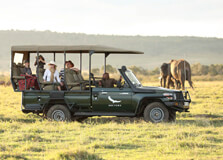
The Masai Mara National Reserve, located in southwestern Kenya, is one of the most renowned and sought-after wildlife destinations in the world. Famous for its abundant wildlife, breathtaking landscapes, and iconic safari experiences, it is a haven for nature lovers, photographers, and adventure seekers. A game drive safari in the Masai Mara is the ultimate way to explore this incredible wilderness, where you can witness the dramatic interactions between animals and the rich diversity of the African ecosystem. Why It's Famous The Masai Mara is globally famous for being the site of the Great Migration, one of the most spectacular natural events on Earth. Every year, millions of wildebeest, zebras, and other herbivores move from Tanzania’s Serengeti to the Masai Mara in search of fresh grazing, followed by predators such as lions, cheetahs, and hyenas. This migration, which takes place from July to October, is a key attraction for visitors embarking on game drive safaris. Aside from the Great Migration, the Masai Mara is home to a wide variety of wildlife, including the "Big Five" (lion, elephant, buffalo, leopard, and rhinoceros). The reserve's vast plains, rolling hills, and savannah offer an authentic African safari experience, with excellent opportunities for birdwatching, photography, and animal sightings. History and Background The Masai Mara is named after the indigenous Maasai people, who have lived in the region for centuries. The word "Mara" is derived from the Maasai language, meaning "spotted" – a reference to the scattered acacia trees that dot the landscape. The reserve itself was established in 1961, and it spans over 1,500 square kilometers (579 square miles) of rolling grasslands, woodlands, and riverine forests. The area is part of the greater Mara-Serengeti ecosystem, which is shared between Kenya and Tanzania. The Masai Mara Reserve is managed by the Narok County Council, while the surrounding conservancies are run by private landowners and community groups. These conservancies allow the local Maasai people to benefit from tourism while helping preserve the region’s wildlife and natural resources. Entry and Visit Details Opening Hours: The Masai Mara is open year-round, but the best time to visit for a game drive safari is during the dry season (from June to October), as the animals tend to congregate around water sources, making them easier to spot. The park is open from 6:00 AM to 6:00 PM, and game drives are typically conducted during the early morning or late afternoon when the animals are most active. Entry Fees: The entry fees to the Masai Mara vary depending on whether you are visiting the Masai Mara National Reserve or one of the private conservancies around the reserve. Entry to the main reserve costs around USD 70 per adult for non-residents, with discounted rates for residents and children. Conservancies may charge higher fees, but they offer a more exclusive and private experience. These fees are usually paid at the park gate upon entry, or they may be included in the cost of an organized safari package. How to Reach Game Drives Safari, Masai Mara The Masai Mara is accessible by road and air from Nairobi, Kenya’s capital, which is about 270 kilometers (168 miles) away. There are several options for getting to the Masai Mara: By Road: The most common way to reach the Masai Mara is by road, which takes about 5-6 hours from Nairobi. The journey can be made via the Narok town route, which is the main gateway to the reserve. The roads are largely tarmacked, but some sections leading to the park may be bumpy, especially during the rainy season. Private vehicles and organized safari tours can be arranged for the drive. By Air: For those seeking a faster and more convenient option, several domestic airlines operate daily flights from Nairobi’s Wilson Airport to airstrips within the Masai Mara. The flight takes about 45 minutes and offers spectacular aerial views of the landscape. Upon arrival, you'll be transferred to your lodge or camp, where your game drive safari can begin. By Shuttle Services: Many tour operators in Nairobi offer shuttle services to the Masai Mara. These shared shuttles offer a more affordable alternative for those traveling on a budget. Weather and Best Time to Visit The Masai Mara has a pleasant, temperate climate, characterized by two main seasons – the dry season and the rainy season: Dry Season (June to October): The best time to visit the Masai Mara for game drives is during the dry season when the weather is warm and sunny, with little rainfall. This period coincides with the Great Migration, and the animals are easier to spot as they gather around water sources. The dry season is also perfect for outdoor activities like game drives, hot air balloon rides, and nature walks. Rainy Season (November to May): While the rainy season (especially in April and May) brings lush green landscapes and fewer tourists, it can make the roads challenging and animals more dispersed, making game drives a bit more difficult. However, this is a good time for birdwatching, as migratory birds flock to the area. Things to Do on a Game Drive Safari in Masai Mara Game drives in the Masai Mara are the highlight of any visit, and there are many activities to enjoy during these safari adventures: Morning and Evening Game Drives: The best time for game drives is early in the morning or late in the afternoon, as this is when animals are most active. During your safari, you’ll have the chance to see the Big Five – lion, leopard, buffalo, elephant, and rhinoceros – as well as cheetahs, giraffes, zebras, wildebeest, and a variety of bird species. Hot Air Balloon Safaris: For a unique and unforgettable experience, consider taking a hot air balloon ride at dawn. Floating above the Masai Mara plains, you’ll have a bird’s-eye view of the animals and the stunning landscape below. The ride is followed by a celebratory breakfast in the bush. Nature Walks: Many lodges and camps in the Masai Mara offer guided nature walks, where you can explore the reserve on foot. Walking safaris are typically led by experienced Maasai guides, who share their knowledge of the flora and fauna of the region. Maasai Cultural Experiences: While in the Masai Mara, take the opportunity to visit a Maasai village and learn about the traditions and way of life of the Maasai people. You can interact with the community, enjoy traditional music and dance, and gain a deeper understanding of the rich culture of this region. Facts and Tips About Game Drives Safari, Masai Mara Pack the Right Gear: Be sure to pack comfortable clothing, sunscreen, a hat, and a camera for your safari. Neutral colors like khaki or brown are ideal as they blend well with the environment. If you’re planning a hot air balloon ride, bring a light jacket as it can get chilly in the early morning. Bring Binoculars and a Camera: The Masai Mara is home to a vast array of wildlife, and you’ll want to capture the moments. Bring binoculars for closer views of animals and a good camera with a zoom lens for excellent wildlife photography. Respect Wildlife: While on a game drive, always follow the instructions of your guide and respect the animals’ space. Keep noise levels low, and never attempt to approach or feed the wildlife. Stay Hydrated: The safari experience can be physically demanding, especially during the warm weather. Bring plenty of water and snacks to keep your energy up throughout the day. Book Your Safari in Advance: Game drive safaris in the Masai Mara can fill up quickly, especially during the high season. It’s a good idea to book your safari well in advance to ensure availability and get the best experience possible. Conclusion A game drive safari in the Masai Mara is an unforgettable experience that provides an opportunity to witness some of the most amazing wildlife interactions on the planet. Whether you’re observing the Great Migration, tracking the Big Five, or simply soaking in the beauty of the African savannah, the Masai Mara offers an adventure like no other. With its breathtaking landscapes, rich biodiversity, and cultural heritage, it is a destination that should be on every traveler’s bucket list. Plan your visit during the dry season for the best wildlife sightings, and get ready for an adventure of a lifetime.
Explore More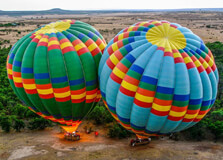
The Masai Mara, located in southwestern Kenya, is one of the most iconic wildlife destinations in the world. Among the many unique ways to experience the stunning landscapes and wildlife of this region, the Hot Air Balloon Safari stands out as one of the most exhilarating and memorable. Floating above the vast savannah, you’ll be treated to an unparalleled bird’s-eye view of the Masai Mara’s breathtaking plains, forests, rivers, and its abundant wildlife. Why Hot Air Balloon Safaris Are Famous in Masai Mara Hot air balloon safaris in the Masai Mara are world-renowned for offering one of the most magical experiences on Earth. The appeal of this adventure lies in the combination of excitement and tranquility as you soar high above the reserve. The view from the balloon provides a completely different perspective on the landscape compared to traditional game drives, offering sweeping views of the wildlife and the entire ecosystem below. What makes the experience even more special is the timing. Balloon rides typically take place at dawn, just as the sun is rising over the savannah. The sky is painted in beautiful hues of orange and pink, and you’ll often witness the wildlife in their most active state—lions waking from their slumber, elephants grazing peacefully, and herds of wildebeest and zebras moving across the plains. The highlight of the experience is often seeing the Great Migration (if you visit between July and October) from the air, with vast herds of wildebeest, zebras, and gazelles making their way across the plains in search of food and water, with predators such as lions and cheetahs trailing them. The aerial view of this spectacle is awe-inspiring and provides fantastic photo opportunities. Entry and Visit Details Opening Hours: Hot air balloon safaris in the Masai Mara typically take place early in the morning, just before sunrise. This allows guests to witness the beautiful dawn light while observing the wildlife as they begin their day. The balloons generally launch between 6:00 AM and 6:30 AM, depending on the time of year. The entire experience usually lasts around 1 to 1.5 hours, followed by a celebratory breakfast in the bush. Booking Your Safari: Hot air balloon safaris in Masai Mara are operated by several tour companies that specialize in ballooning. It’s advisable to book your safari in advance, especially during the high season (from July to October), as these rides are highly sought after. Many safari operators offer balloon safari packages that include transportation, a guide, and additional safari activities. These packages often include a game drive or cultural experience, along with your balloon ride. Cost: The price of a hot air balloon safari in the Masai Mara varies, but it typically ranges from USD 450 to USD 550 per person. This cost includes the flight, a certificate of completion, a champagne toast after landing, and a hearty breakfast. The price may vary depending on the tour operator and any additional services offered. How to Reach Hot Air Balloon Safaris, Masai Mara The Masai Mara is located around 270 kilometers (168 miles) southwest of Nairobi, the capital of Kenya. While the hot air balloon rides themselves take off from various launch sites within the reserve, getting to the Masai Mara is the first step to begin your adventure: By Road: You can drive from Nairobi to the Masai Mara, a journey that takes about 5 to 6 hours, depending on traffic and road conditions. The drive is scenic and passes through the Great Rift Valley, offering views of beautiful landscapes along the way. Many visitors opt for organized safari packages that include transportation and a guided safari experience in the Mara. By Air: For a quicker journey, you can fly to the Masai Mara from Nairobi’s Wilson Airport. There are several daily scheduled flights that take around 45 minutes. The flight will land at one of the airstrips located within the reserve, from where you will be transferred to your lodge or camp. Many flight services are coordinated with balloon safari companies, so your travel will be seamlessly connected to your balloon ride experience. Weather and Best Time to Visit for Hot Air Balloon Safaris The Masai Mara enjoys a moderate climate, with two main seasons: the rainy season and the dry season. The best time to visit for a hot air balloon safari is during the dry season, from June to October. During this time, the weather is generally warm and sunny, making it ideal for outdoor activities like ballooning. The dry season also coincides with the Great Migration, which attracts numerous visitors who want to witness this extraordinary natural event from the air. During the rainy season (from November to May), the weather can be unpredictable, with intermittent rains and occasional thunderstorms. While the landscape is lush and green during these months, the rains can sometimes cause delays or cancellations of balloon rides. However, this season offers a quieter experience with fewer tourists and excellent birdwatching opportunities. Things to Do During Your Hot Air Balloon Safari While the main highlight of the hot air balloon safari is the aerial view of the Masai Mara, there are several other activities that enhance the overall experience: Champagne Breakfast: After the balloon flight, you’ll enjoy a sumptuous breakfast in the heart of the Masai Mara. This celebratory meal, often served with a glass of champagne, is a great way to relax and reflect on the experience. Game Drives: Many safari operators combine hot air balloon rides with morning or afternoon game drives, allowing you to explore the Mara on the ground after your balloon flight. These drives offer a chance to see animals up close and gain insights from experienced safari guides. Cultural Visits: Some tour packages include visits to nearby Maasai villages, where you can learn about the rich culture and traditions of the Maasai people. This cultural experience adds an enriching element to your safari. Photography and Wildlife Viewing: The balloon ride itself offers incredible photo opportunities. As you glide silently over the plains, you’ll have a chance to capture stunning images of wildlife and the dramatic landscape below. The balloon also provides a unique perspective on the wildlife behavior, with herds of elephants, wildebeest, and lions often visible in their natural habitats. Facts and Tips About Hot Air Balloon Safaris in Masai Mara Safety: Hot air ballooning in the Masai Mara is a safe and regulated activity. The balloon operators adhere to international safety standards, with experienced pilots and well-maintained equipment. However, it’s always important to follow all safety instructions provided by your balloon crew. Dress Appropriately: Since the balloon ride takes place early in the morning, it can be chilly at higher altitudes. Wear layered clothing and bring a light jacket or sweater. Comfortable shoes are also recommended for walking during the breakfast and game drive portions of the safari. Book in Advance: Hot air balloon rides are highly popular, especially during the peak tourist season. It’s advisable to book your balloon safari several months in advance to secure your spot. Capture the Moment: Don’t forget your camera or smartphone! The view from the balloon offers unparalleled photo opportunities. The animals below, the sunrise, and the vast landscapes of the Masai Mara are all picture-perfect moments. Consider the Cost: Hot air balloon safaris are a premium experience and come at a higher cost than regular game drives. However, the unique nature of the experience and the memories you’ll make are well worth the investment. Conclusion A hot air balloon safari in the Masai Mara is a once-in-a-lifetime experience that offers an unforgettable perspective on one of the world’s most famous wildlife reserves. From witnessing the Great Migration from the air to enjoying a peaceful breakfast in the bush, this activity provides a truly unique way to connect with nature. Whether you are an adventure seeker, a wildlife enthusiast, or simply someone who enjoys beautiful views, a balloon ride in the Masai Mara is an experience you will treasure forever.
Explore More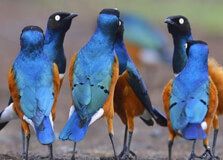
The Masai Mara, one of Kenya's most famous wildlife reserves, is not only known for its rich wildlife and dramatic landscapes but also as a prime destination for birdwatching enthusiasts. A birdwatching safari in Masai Mara offers an extraordinary opportunity to see a variety of bird species in their natural habitat, making it a must-visit location for bird lovers from around the world. The reserve is home to over 500 species of birds, ranging from colorful and rare species to more common ones, making it a haven for ornithologists and casual birdwatchers alike. Why Birdwatching Safaris Are Famous in Masai Mara Masai Mara is world-renowned for its biodiversity, and its birdlife is just as impressive. The reserve’s diverse ecosystems, including savannahs, woodlands, riverine forests, and wetlands, provide the perfect environment for a vast array of bird species. Some of the most notable birds to be found in the Masai Mara include the African Fish Eagle, Secretary Bird, Martial Eagle, Lilac-breasted Roller, and various species of hornbills, ostriches, and vultures. The variety of habitats within the park ensures that birdwatchers can observe a wide range of species in different settings, from the open plains to the banks of the Mara River. Another reason Masai Mara is so popular for birdwatching is that it is part of the greater Serengeti ecosystem, which provides ample opportunities to observe migratory birds. Many species visit the Mara during the migration season (between October and April), adding to the diversity of birds found in the area. The dramatic landscapes, combined with the abundance of birds, make birdwatching in the Masai Mara a truly unique experience. Entry and Visit Details Opening Hours: The Masai Mara National Reserve is open year-round, with no specific opening hours. Birdwatching safaris are typically conducted during daylight hours, with early morning and late afternoon being the best times for birdwatching. These hours are particularly ideal for spotting active birds as they begin or end their day. During the early morning, the temperatures are cooler, and birds tend to be more active, while in the late afternoon, the birds are often seen returning to their nests. Booking Your Birdwatching Safari: Birdwatching safaris in the Masai Mara can be booked through various safari operators that offer specialized birdwatching tours. These tours are led by experienced bird guides who are well-versed in identifying local bird species and their behaviors. Many operators also offer customized birdwatching packages that include game drives, walks, and visits to birding hotspots within the park. It's highly recommended to book your birdwatching safari in advance, especially during peak seasons like the migration months or holiday periods. Cost: The cost of birdwatching safaris in Masai Mara depends on the type of tour and services included. On average, a half-day birdwatching safari can cost around USD 150 to USD 250 per person, while full-day safaris may range between USD 300 and USD 400. If you prefer a private tour or a specialized photography safari, the cost may be higher. These prices usually include the cost of the safari vehicle, the guide, and sometimes park entrance fees. Ensure to confirm what is included in the package before booking. How to Reach Birdwatching Safaris, Masai Mara Reaching Masai Mara for a birdwatching safari is relatively straightforward, with several transportation options available from Nairobi or other major cities in Kenya. Here are the main ways to reach the reserve: By Road: The most common and affordable way to reach Masai Mara is by road. You can drive from Nairobi, which takes about 5 to 6 hours, depending on road conditions and traffic. The journey from Nairobi to the Mara takes you through the scenic Great Rift Valley and offers a chance to observe the changing landscapes. Many safari tour companies provide road transport as part of their package, making it a convenient option for visitors. By Air: The quickest way to reach the Masai Mara is by air. There are daily scheduled flights from Nairobi’s Wilson Airport to several airstrips in the Masai Mara, with flight times of about 45 minutes. Flying is the preferred choice for many visitors as it saves time and provides a scenic aerial view of the Great Rift Valley and Masai Mara. Upon arrival at the airstrip, you will be transferred to your lodge or camp for your birdwatching safari. Weather and Best Time to Visit for Birdwatching Safaris Masai Mara has a moderate climate, which makes it an ideal year-round destination for birdwatching. However, the best time to visit for birdwatching safaris is during the dry season, which runs from June to October. During this time, the weather is sunny and the vegetation is less dense, making it easier to spot birds. The dry season is also the peak time for bird migrations, with numerous species arriving in the Mara from Europe and Asia. Another great time for birdwatching is during the short rainy season, which occurs from November to December. This is when migratory birds, particularly from Europe, are in full swing. The long rainy season, from March to May, is typically avoided by most birdwatchers due to heavy rains and muddy roads, but it does bring lush vegetation, which attracts a different set of species. Things to Do During Your Birdwatching Safari In addition to observing the incredible birdlife, a birdwatching safari in Masai Mara can be a fully immersive experience, offering plenty of activities for visitors: Guided Birdwalks: Many lodges and camps in Masai Mara offer guided birdwalks with expert bird guides. These walks take you through forests, wetlands, and other habitats, allowing you to observe various species in close proximity. Game Drives: Although birdwatching is the main focus, combining it with a game drive adds to the experience. The Mara is home to the “Big Five” (lions, leopards, elephants, buffalo, and rhinos), and spotting these animals while birdwatching can be an exciting bonus. Photography: Birdwatching in the Masai Mara offers excellent opportunities for wildlife photography. Whether you’re capturing the intricate details of a lilac-breasted roller or a majestic eagle in flight, the light and scenery are perfect for stunning photos. Cultural Visits: Some birdwatching tours also include visits to nearby Maasai villages. Learning about the local culture and traditions of the Maasai people offers a deeper understanding of the region, complementing your wildlife and birding experience. Facts and Tips About Birdwatching Safaris in Masai Mara Bring the Right Equipment: If you are an avid birdwatcher, it’s essential to bring your binoculars and a field guidebook for birds. While guides are always helpful, having your own equipment ensures you don’t miss any of the incredible species. Dress for Comfort: Wear light, neutral-colored clothing to avoid attracting attention from the birds. Sturdy, comfortable shoes are a must for walking safaris. Since mornings and evenings can be cool, it’s recommended to layer your clothing. Hire a Professional Guide: While it’s possible to spot birds on your own, hiring an expert bird guide greatly enhances the experience. Guides are knowledgeable about the bird species, their behaviors, and the best places to spot them. They also know how to track down elusive birds that might otherwise be missed. Be Patient: Birdwatching often requires patience. Take your time to observe and listen carefully. Many birds are more easily detected by their calls rather than their appearance, so it’s essential to be quiet and attentive. Support Conservation Efforts: Masai Mara is part of ongoing conservation initiatives that aim to protect both wildlife and bird species. Support these efforts by respecting wildlife, following park regulations, and contributing to eco-friendly tours. Conclusion Birdwatching in Masai Mara offers a unique and enriching way to experience one of Africa’s most famous wildlife reserves. Whether you’re an experienced birdwatcher or simply someone looking to appreciate the beauty of nature, a birdwatching safari in the Masai Mara promises an unforgettable adventure. With over 500 species of birds, incredible landscapes, and expert guides, Masai Mara is undoubtedly one of the best places on Earth to witness the diversity of avian life in its natural habitat.
Explore More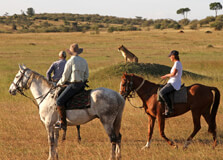
Horse riding in Masai Mara is a thrilling and unique way to explore one of Kenya's most famous wildlife reserves. While most visitors to the Mara choose to experience the region on foot or by vehicle, horse riding offers an entirely different perspective, allowing you to immerse yourself in the stunning landscapes of the Mara and get up close to its diverse wildlife. Whether you're an experienced rider or a beginner, horse riding safaris provide a magical way to connect with nature and experience the beauty of the African wilderness from a different angle. Why Horse Riding in Masai Mara is Famous Masai Mara is renowned for its abundant wildlife, including the “Big Five” (lions, leopards, elephants, buffalo, and rhinoceros), as well as its spectacular scenery. Horse riding offers a more intimate and peaceful experience than traditional safari vehicles, allowing you to get closer to nature and wildlife in a way that feels more natural and less intrusive. Riding through the Mara’s open savannahs, riverine forests, and acacia woodlands provides a chance to observe the reserve’s wildlife from a unique perspective. The quietness of horseback riding means that animals are less disturbed, and riders often have the opportunity to approach animals more closely than they would in a vehicle. Horse riding also allows for a deeper connection to the landscape. The Mara’s vast plains, dramatic river valleys, and rolling hills are best appreciated from horseback, as it enables you to travel across vast areas of land that might be difficult to reach by foot or vehicle. The experience is exhilarating, offering an unparalleled sense of freedom as you trot, canter, or gallop through the wilds of Masai Mara. Entry and Visit Details About Horse Riding in Masai Mara Booking a Horse Riding Safari: Horse riding safaris in Masai Mara are offered by several luxury lodges and camps within the reserve. Most lodges have partnerships with experienced safari operators who specialize in horseback safaris. These operators typically provide a range of packages, including short rides (lasting a couple of hours) and full-day safaris. Some operators also offer multi-day rides that can be tailored to specific interests, such as wildlife photography or birdwatching. Requirements: While horse riding safaris are open to people of all riding abilities, there are certain age and health restrictions. Most operators require riders to be at least 12 years old, but some allow younger children if they have prior riding experience. Beginners are welcome, and the horses are well-trained and suitable for riders of all levels. Most safari operators also provide training for first-timers and ensure that riders are comfortable with the horses before setting off on a safari. It is important to notify the operator about your experience level when booking, so they can assign an appropriate horse and guide. Cost: The cost of a horse riding safari in Masai Mara varies depending on the duration and type of ride. A typical half-day ride can range from USD 150 to USD 250 per person, while full-day safaris can cost upwards of USD 300 per person. If you're interested in a longer, more customized ride, or if you'd like to include meals, overnight stays, or additional activities, the cost will be higher. These prices typically include the horse, guide, and sometimes a picnic or refreshments during the ride. It's always best to confirm the full details and inclusions with the operator before booking. How to Reach Horse Riding in Masai Mara Reaching Masai Mara for a horse riding safari is relatively easy from Nairobi, Kenya’s capital. There are two main options for getting to the Mara: By Road: The most common way to reach Masai Mara is by road. The drive from Nairobi to Masai Mara typically takes around 5 to 6 hours, depending on road conditions. The journey will take you through the beautiful Great Rift Valley and into the heart of the Mara, where you’ll encounter breathtaking views of rolling plains and distant hills. If you’re staying at a lodge or camp in the Mara, they will likely provide a transfer from Nairobi, which may be included in your safari package. By Air: The quickest way to get to Masai Mara is by flying from Nairobi’s Wilson Airport to one of the Mara’s airstrips. Scheduled flights are available daily, and the flight typically takes about 45 minutes. This is a popular option for visitors looking to save time and experience aerial views of the Great Rift Valley and the Masai Mara. Upon landing, you’ll be transferred to your lodge or camp, where your horse riding safari will begin. Weather and Best Time for Horse Riding in Masai Mara The weather in Masai Mara is generally temperate throughout the year, with distinct wet and dry seasons. The best time for horse riding safaris is during the dry season, which runs from June to October. This is when the landscape is lush, the vegetation is lower, and wildlife is more easily spotted as they gather around water sources. Additionally, the dry season offers more stable weather conditions, making it ideal for outdoor activities like horse riding. The short rainy season occurs between November and December, and while this time can offer a quieter and more serene experience, it also means wetter trails and occasional showers. The long rainy season, from March to May, is typically avoided by most visitors, as heavy rains can lead to muddy roads and less-than-ideal riding conditions. If you're looking for good weather for a horse riding safari, the dry months between June and October are the best time to visit. Things to Do During Horse Riding Safaris in Masai Mara Horse riding safaris in Masai Mara offer a wide variety of experiences that go beyond just riding through the reserve. Here are some activities you can enjoy during your ride: Wildlife Watching: Horseback riding allows you to get closer to wildlife without disturbing them. During your ride, you may encounter zebras, giraffes, wildebeests, and other wildlife species. You might also spot predators such as lions, cheetahs, and hyenas in the distance. The quiet nature of horseback riding makes it easier to observe wildlife up close. Scenic Views and Photography: The Masai Mara’s landscapes are some of the most dramatic in the world, and a horse riding safari offers a perfect vantage point to capture stunning photographs. Whether it’s the golden plains dotted with acacia trees, the rolling hills, or the winding Mara River, there are countless breathtaking views to enjoy. Guided Bush Walks: Some operators offer the option to stop during your ride for a guided bush walk. This provides an opportunity to learn more about the flora and fauna of the Mara, as well as the cultural significance of the land to the Maasai people. Cultural Experiences: Many safari operators arrange visits to nearby Maasai villages. Here, you can learn about the traditions and lifestyles of the Maasai people, including their traditional dances, rituals, and customs. This offers a fascinating contrast to the wildlife experience and provides a deeper understanding of the region’s culture. Facts and Tips About Horse Riding in Masai Mara Safety First: While horse riding safaris in Masai Mara are safe and enjoyable, always prioritize safety. Wear a helmet (which is typically provided by the tour operator) and follow the guide's instructions. It’s important to ride at a comfortable pace and ensure that you are familiar with the horse before heading out. Dress Appropriately: Wear lightweight, comfortable clothing, preferably in neutral or earthy colors. Long sleeves and pants are recommended to protect against sun exposure and brush. Sturdy shoes, preferably riding boots, will make the ride more comfortable. Respect Wildlife: Always respect the animals and maintain a safe distance from them. While horse riding offers a closer experience, it’s important to remember that you’re still a guest in their environment. Don’t Forget Your Camera: Horseback riding in the Mara offers plenty of opportunities for incredible wildlife and landscape photography, so bring a camera with a good zoom lens to capture those unforgettable moments. Stay Hydrated: While exploring the Mara on horseback, remember to bring water, especially during the hotter months. The sun can be intense, and staying hydrated is essential for enjoying the experience. Conclusion Horse riding in Masai Mara is an extraordinary way to experience the magic of this iconic African landscape. Whether you're an experienced rider or a beginner, the opportunity to ride through the stunning savannah, encounter wildlife up close, and connect with nature in such a peaceful manner is truly unforgettable. Whether you're looking for an adventure, a photographic opportunity, or simply a chance to unwind and enjoy the beauty of the Mara, a horse riding safari offers an unparalleled experience in one of the world's most famous wildlife reserves.
Explore More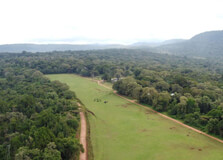
Cherang'any Hills About The Cherang'any Hills at Kitale Tour The Cherang'any Hills, located near the town of Kitale in Kenya's Rift Valley region, offer visitors a captivating journey into the breathtaking landscapes and cultural heritage of the region. Rising majestically above the surrounding plains, the Cherang'any Hills are renowned for their stunning vistas, lush greenery, and diverse ecosystems, making them a haven for nature lovers and outdoor enthusiasts. The hills are also steeped in history and culture, with ancient caves, rock art sites, and traditional villages scattered throughout the area, providing a glimpse into the rich cultural heritage of the local communities. Cherang'any Hills at Kitale The Cherang'any Hills can be visited year-round, although the best time to explore the area is during the dry season from June to September when the weather is mild, and hiking conditions are optimal. Visitors are advised to avoid the rainy season from October to May, as heavy rainfall can make the trails slippery and challenging to navigate. Entry Fee There is no entry fee to access the Cherang'any Hills, as they are open to the public for exploration and enjoyment. However, visitors may need to pay a small fee for guided tours or access to specific attractions within the area, such as rock art sites or cultural villages. Prices for these activities can vary depending on the operator and the type of experience offered. Time Required for Travel Traveling to the Cherang'any Hills from Kitale town typically takes around 1 to 1.5 hours by car, depending on road conditions and the route taken. The journey offers scenic views of the surrounding countryside, with opportunities to stop and take photos along the way. Visitors should plan to spend at least a half-day exploring the Cherang'any Hills and its surrounding attractions, although full-day excursions are also possible for those looking to immerse themselves in the natural beauty and cultural heritage of the region. Traveling Tips Before embarking on a tour of the Cherang'any Hills at Kitale, it's essential to be prepared for the outdoor experience. Dress appropriately for the weather and wear comfortable clothing and sturdy footwear suitable for hiking and walking on uneven terrain. Bring along plenty of drinking water, snacks, sunscreen, a hat, and insect repellent to stay hydrated and protected from the elements. It's also a good idea to carry a map, compass, or GPS device to help navigate the trails and ensure a safe and enjoyable hiking experience. Lastly, respect the environment and local communities by following any rules or guidelines provided by tour operators and park authorities, leaving only footprints and taking only memories of your adventure in the Cherang'any Hills.
Explore More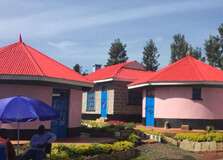
The Soy Safari Park is mentioned as one of the places to visit in Kitale, situated in the Rift Valley's picturesque landscapes. However, detailed information about specific facilities and attractions within the park is limited in current online sources. Soy Safari Park is nestled in the scenic landscapes of Kitale in Kenya's Rift Valley region. Kitale is located in Trans-Nzoia County, in the western highlands of Kenya near the border with Uganda. Nearby Attractions of Soy Safari Park Major Attractions Near Kitale: Saiwa Swamp National Park - North of Kitale, this small, rarely visited national park is a real treat for those not seeking the Big Five Mount Elgon National Park - Located nearby for hiking and nature experiences Cherang'any Hills - Located near Kitale in Kenya's Rift Valley region Kitale Nature Conservancy - Another natural attraction in the area Kitale Museum - Located about 1 km from the town center Kitale Golf Club - For recreational activities Things to Do at Soy Safari Park While specific activities at Soy Safari Park aren't detailed in current sources, typical safari park activities in the region include: Wildlife viewing and photography Nature walks and guided tours Bird watching Picnic activities Educational tours about local wildlife and conservation Opening and Closing Times Information Not Available: Current search results don't provide specific operating hours for Soy Safari Park. It's recommended to contact the park directly or local tour operators for current timing information. How to Reach Soy Safari Park By Road: Kitale is accessible via the A1 highway from Nairobi (approximately 350 km) From Eldoret: About 60 km via the A1 highway Local transport: Matatus (shared taxis) and boda bodas (motorcycle taxis) are available within Kitale By Air: Kitale Airstrip serves the area with scheduled and charter flights Eldoret International Airport is the nearest major airport (about 60 km away) Best Time to Visit Soy Safari Park Recommended Seasons: Dry Season (June-October & December-March): Best for wildlife viewing as animals congregate around water sources Weather: Kitale enjoys a relatively mild climate year-round due to its elevation Avoid: Heavy rainy seasons (April-May and November) when roads may be challenging Entry Fee There is an entry fee to access the Soy Safari Park, with prices varying depending on age, nationality, and any additional activities or amenities included in the visit. Visitors are advised to check the official Soy Safari Park website or contact park authorities directly for up-to-date information on entry fees and any discounts or promotions available. Time Required for Travel Traveling to the Soy Safari Park from Kitale town typically takes around 30 minutes to an hour by car, depending on road conditions and the route taken. The journey offers scenic views of the surrounding countryside, with opportunities to spot wildlife along the way. Visitors should plan to spend at least a half-day exploring the Soy Safari Park and its surrounding attractions, although full-day excursions are also possible for those looking to immerse themselves in the natural beauty and wildlife of the region. Traveler Tips for Soy Safari Park Planning Tips: Contact local tour operators in Kitale for current information about the park Combine your visit with nearby attractions like Saiwa Swamp National Park Bring appropriate clothing for varying weather conditions Pack sunscreen, hat, and insect repellent Carry cash as card facilities may be limited in rural areas Accommodation: Various hotels and lodges are available in Kitale town Consider staying overnight to fully explore the area's attractions Photography: Bring extra batteries and memory cards Early morning and late afternoon offer the best lighting for wildlife photography Note: Due to limited current online information specifically about Soy Safari Park, I recommend contacting the Kenya Wildlife Service (KWS) or local tourism offices in Kitale for the most up-to-date information about facilities, entrance fees, and specific attractions within the park.
Explore More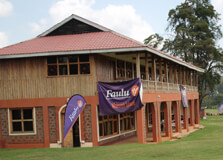
Kitale Golf Club About The Kitale Golf Club Nestled in the serene landscapes of Kitale, Kenya, the Kitale Golf Club stands as a distinguished hub for golf enthusiasts and a cultural landmark in the region. Established with a rich history dating back decades, the club offers not only a challenging 18-hole course but also a welcoming atmosphere for players of all skill levels. Surrounded by lush greenery and breathtaking views of Mount Elgon, the Kitale Golf Club provides a tranquil escape for both locals and visitors alike, fostering a sense of community and camaraderie among its members. History of Kitale Golf Club Founded in [year of establishment], the Kitale Golf Club has evolved from its humble beginnings into a prominent fixture in Kenya's golfing scene. Originally conceived by [founder's name] and a group of passionate golf enthusiasts, the club was envisioned as a recreational haven amidst Kitale's natural beauty. Over the years, it has hosted numerous tournaments and events, attracting players from across the country and beyond. Through dedicated stewardship and ongoing renovations, the Kitale Golf Club continues to uphold its legacy as a premier destination for golfing excellence in East Africa. Time to Visit The Kitale Golf Club welcomes visitors year-round, although the best times to visit coincide with the region's dry seasons, typically from [months]. During these months, golfers can enjoy favorable weather conditions and clear skies, enhancing their experience on the course. It's advisable to check the club's schedule for any upcoming tournaments or events that may influence course availability. Entry Fee Visitors to the Kitale Golf Club are required to pay an entry fee of [amount], which grants access to the course and facilities. Special rates may apply for guests accompanied by members, and discounts are often available for juniors and seniors. Fees contribute to the maintenance and upkeep of the course, ensuring optimal playing conditions and amenities for all who visit. Time Required for Travel Traveling to Kitale Golf Club from [nearest major city or airport] typically takes approximately [number] hours by road. The journey offers scenic views of Kenya's countryside, showcasing the country's diverse landscapes along the way. For those arriving by air, flights to [nearest airport] are available regularly, followed by a [number] hour drive to the club. It's recommended to plan ahead and confirm transportation arrangements to ensure a smooth journey. Traveling Tips Golf Equipment: Bring your own golf clubs and accessories, although rentals may be available at the club for convenience. Attire: Adhere to the club's dress code, which often includes collared shirts and proper golfing attire. Reservations: Make reservations for tee times in advance, especially during peak seasons or weekends. Local Attractions: Explore nearby attractions such as Mount Elgon National Park or local markets to enhance your visit to Kitale. Etiquette: Respect golf etiquette and course rules, including pace of play and care for the course to ensure an enjoyable experience for all players. In conclusion, the Kitale Golf Club offers more than just a golfing experience; it embodies a tradition of excellence and community spirit in Kenya's picturesque Kitale region. Whether you're a seasoned golfer seeking a new challenge or a visitor looking to enjoy the beauty of East Africa, a visit to this historic club promises memories and moments to cherish amidst stunning natural surroundings
Explore More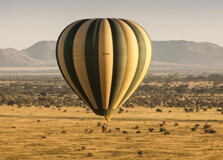
Maasai mara Game Reserve Ballon Safari
The Maasai Mara Game Reserve is one of Kenya’s most famous wildlife reserves, known for its rich biodiversity, especially during the annual Great Migration. Among the many exciting activities in the Mara, the hot air balloon safari stands out as one of the most unique and thrilling ways to experience the wild beauty of the reserve. Floating high above the savannah, you get a bird's-eye view of the diverse landscapes, wildlife, and dramatic views that make the Maasai Mara a world-renowned destination. This once-in-a-lifetime experience offers a sense of serenity and adventure all in one. How to Reach Maasai Mara Game Reserve Balloon Safari, Narok Reaching Maasai Mara for a hot air balloon safari involves traveling from Nairobi to the Maasai Mara Game Reserve, where several companies operate balloon safaris. Here are the steps for getting there: By Road: The most common way to reach Maasai Mara is by road from Nairobi, which is about 270 kilometers away. The drive takes approximately 5 to 6 hours, depending on the road conditions. The route passes through Narok town, and then visitors continue towards the various gates of the Maasai Mara Game Reserve. While roads are passable, it’s recommended to use a 4x4 vehicle to handle the rough terrain in the reserve. By Air: Alternatively, you can fly from Nairobi’s Wilson Airport to one of the airstrips in the Maasai Mara. Flights take about 45 minutes. Once you arrive, you'll be picked up by a vehicle from the balloon safari operator to the launch site. Flights to airstrips such as Keekorok or Ol Kiombo are frequent, and you can book a flight with various safari operators. This option is faster and more convenient if you're short on time. From Muscat: To reach Maasai Mara from Muscat, you need to fly into Nairobi’s Jomo Kenyatta International Airport. From there, follow the above travel options, either by road or by air. Weather in Maasai Mara Game Reserve Balloon Safari The weather in the Maasai Mara is typically mild and temperate, which makes it a great year-round destination for safaris, including balloon rides. The daytime temperatures generally range from 20°C to 30°C, with cooler nights. The region experiences two distinct seasons: Rainy Season: The long rains are from March to May, and the short rains occur from November to December. During this time, the landscape is lush and green, but some roads in the Mara may become muddy and harder to navigate. Dry Season: From June to October, the weather is typically dry and sunny. This is the peak time for wildlife viewing, especially during the Great Migration. The clear skies during the dry months make it the perfect time for a hot air balloon safari, offering unparalleled views of the landscape. The best time to take a balloon safari is during the dry months of the year (June to October) when visibility is clearer, and the wildlife is more concentrated around water sources. Why Maasai Mara Game Reserve Balloon Safari is Famous The Maasai Mara Game Reserve balloon safari is one of the most iconic and sought-after safari experiences in the world. It offers a unique perspective on the vast savannah and its inhabitants. From the balloon, you can witness the dramatic landscapes of the Mara, including the river crossings of the Great Migration, which is one of the Seven Natural Wonders of the World. Aside from the wildlife, the hot air balloon ride provides a serene and peaceful experience. There is something magical about floating silently above the plains, watching herds of elephants, lions, giraffes, and zebras from a bird's-eye view. The balloon ride usually begins at sunrise, giving visitors the chance to witness the Mara’s wildlife during its most active time of day. The Maasai Mara Game Reserve Balloon Safari is also famous for the luxurious experience it offers. Many safari operators provide a champagne breakfast after the balloon flight, allowing you to savor the moment while watching the wildlife below you. This makes it not just a safari experience but a luxury adventure as well. Entry and Visit Details About Maasai Mara Game Reserve Balloon Safari, Narok To experience a balloon safari, visitors must first gain entry to the Maasai Mara Game Reserve. The entry fees for the Maasai Mara vary depending on whether you are a resident, non-resident, or a citizen of Kenya, and they are paid at the reserve’s gate. Once you enter, you can proceed to your designated lodge or camp, where you’ll meet your balloon safari operator. The balloon safari itself typically lasts between 1 and 1.5 hours, depending on the weather conditions and the flight route. The safari company provides a full briefing before the flight, covering safety protocols, and then you are taken to the launch site, where you will begin your journey over the Mara plains. The best time for the balloon ride is early in the morning, just before sunrise, as this is when the winds are most favorable and wildlife activity is at its peak. Booking a Maasai Mara Balloon Safari in advance is essential, especially during the high season (June to October). The price of the safari often includes the flight, park entry fees, a certificate of flight, and a celebratory champagne breakfast. It’s best to check with your lodge or safari operator for specific pricing and availability. History and Architecture of Maasai Mara Game Reserve Balloon Safari The Maasai Mara Game Reserve itself was established in 1961, and over time it has grown into one of the most famous wildlife reserves in Africa. The concept of hot air balloon safaris began as a way to offer a unique way of viewing the vast savannah, which was not possible from a traditional safari vehicle. The first balloon safari in Maasai Mara took place in the 1970s, and since then it has become a must-do experience for tourists visiting the reserve. In terms of architecture, the Maasai Mara Balloon Safari companies do not operate any permanent structures on the reserve. Instead, visitors stay in luxury lodges or tented camps, which are spread throughout the reserve, designed to blend seamlessly with the natural environment. These camps offer comfortable accommodations with modern amenities and are strategically located near areas where wildlife is frequently spotted. Things to Do at Maasai Mara Game Reserve Balloon Safari, Narok While the hot air balloon safari is the highlight, there are many other exciting activities you can enjoy in Maasai Mara: Game Drives: Safari game drives are one of the most popular activities in the Mara. A traditional game drive in a safari vehicle allows you to get closer to the wildlife and view the animals at ground level. These drives are led by expert guides who can provide insightful information about the animals and the ecosystem. Guided Nature Walks: Explore the Mara on foot with a local Maasai guide. These walks provide an intimate experience with nature, where you can learn about local plants, animals, and the Maasai culture. Visit Maasai Villages: Discover the traditional lifestyle of the Maasai people by visiting their villages. Engage with the community, learn about their customs, and even participate in traditional ceremonies. Photography Safaris: The Mara is a photographer’s paradise. Whether it’s capturing the Great Migration or photographing a pride of lions resting under the shade, there are countless photo opportunities in the reserve. Interesting Facts About Maasai Mara Game Reserve Balloon Safari, Narok The Maasai Mara Balloon Safari takes off at dawn, giving you the chance to see the sun rise over the savannah. Each balloon can carry up to 16 passengers, depending on the size of the balloon and the safari operator. The Maasai Mara Balloon Safari is one of the few places in the world where you can experience the Great Migration from the air. Hot air balloons in the Mara are flown by experienced pilots, many of whom are licensed by the Kenyan Civil Aviation Authority. Tips for Visiting Maasai Mara Game Reserve Balloon Safari, Narok Book in Advance: Balloon safaris are in high demand, especially during the migration season. Be sure to book your spot well in advance. Wear Layers: Early mornings can be chilly in the Mara, so wear warm clothing, but bring light layers that you can remove as the day heats up. Carry a Camera: The views from the balloon are spectacular, so don’t forget your camera or smartphone to capture the moment. Bring Binoculars: While the balloon flight offers a fantastic view of the wildlife, binoculars will allow you to get a closer look at distant animals. Respect the Environment: Be mindful of the natural environment and the wildlife around you. Do not disturb animals and follow your pilot’s instructions at all times.
Explore More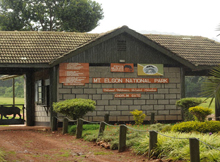
Rupa’s Mall ‘Kid Corner’ is a lively and thoughtfully crafted children’s entertainment area located within Rupa’s Mall, one of the most popular shopping and leisure destinations in Eldoret, Kenya. Designed specifically to meet the recreational and developmental needs of children, the Kid Corner offers a wide range of engaging activities suitable for different age groups. The space promotes not only physical play but also encourages creativity, cognitive development, and social interaction in a controlled and safe environment. With brightly colored interiors, soft play areas, ball pits, slides, trampolines, and interactive play zones, the Kid Corner serves as a hub of excitement and learning for children while offering peace of mind to parents. Features and Facilities Safe and Clean Play Area: All equipment and surfaces are well-maintained, sanitized regularly, and comply with child safety standards. Age-Specific Zones: Different play areas are available for toddlers, preschoolers, and older children, ensuring age-appropriate activities. Interactive Games: Educational toys, puzzles, role-play sections, and sensory play are part of the experience. Seating Area for Parents: Comfortable seating is available for parents and guardians who want to supervise or relax while children play. Supervised Play: Trained staff monitor activities and assist children, ensuring both safety and fun. History and Vision Rupa’s Mall introduced the ‘Kid Corner’ in response to the growing need for family-oriented indoor spaces in Eldoret. The management envisioned a space where children could enjoy screen-free activities while parents shop, dine, or simply relax nearby. From its humble beginnings, the Kid Corner has grown into a popular venue for not just casual visits but also birthday parties, school outings, and community events. Continuous upgrades and parental feedback have helped shape the Kid Corner into one of Eldoret’s most cherished family hotspots. Best Time to Visit You can visit the Kid Corner year-round during Rupa’s Mall operating hours, typically: Monday to Sunday: 9:00 AM – 8:00 PM Recommended Visiting Times: Weekdays (Morning to Afternoon): Ideal for toddlers or families seeking a quiet, less crowded environment. Weekends and School Holidays: Best for those looking to enjoy festive atmospheres, special events, or extended play sessions. However, it can be busier during these times. Entry Fees and Packages The pricing at Rupa’s Mall ‘Kid Corner’ is affordable and tailored to suit families from all walks of life. While prices may vary slightly over time or with events, here is an estimated structure: Single Entry (Per Child): KES 300 – KES 500 (depending on duration and age) Group Bookings: Discounts are available for school groups, birthdays, or playdate bookings. Membership or Loyalty Cards: Some packages offer multi-visit deals or monthly passes at discounted rates. Special discounts and promotional offers may also be available during festive seasons or back-to-school campaigns. What to Expect and What to Carry When visiting the Kid Corner, here are a few things to carry to enhance your visit: What to Carry: Comfortable Clothing: Dress your child in flexible, breathable clothes and closed shoes. Water Bottle: Keeping children hydrated is important during active play. Snacks: Though refreshments may be available, packing a few snacks can be useful, especially for longer visits. Socks: Some play areas may require socks, particularly if soft play equipment is involved. Hygiene Essentials: Wet wipes, hand sanitizer, and tissues for quick clean-ups. Food and Refreshments While the Kid Corner focuses on play, the food court and cafes within Rupa’s Mall are within easy reach and offer a variety of options: Kid-Friendly Meals: Pizza, chicken nuggets, burgers, fries, and juices. Healthy Choices: Fresh fruit cups, yoghurt, smoothies, and light wraps. Parent Favorites: Coffee shops, bakeries, and full-service restaurants provide ample variety for adults. Some birthday party packages also include customized catering options for children. How to Reach Rupa’s Mall ‘Kid Corner’ From Eldoret City Center: By Car/Taxi: 15–30 minutes depending on traffic. By Matatu/Public Transport: Easily accessible with matatus heading toward Uganda Road or Iten Road. Boda Boda (Motorbike Taxi): A quick and convenient way for short distances within town. Rupa’s Mall is located along Uganda Road, a well-connected and easily identifiable area in Eldoret. Parking: Ample Parking: Free and secure parking is available for visitors. It’s advisable to arrive early on weekends or holidays for closer parking. Travel Time and Planning Depending on your location within Eldoret: CBD to Rupa’s Mall: 20–25 minutes by car Kapsoya Area: Around 10–15 minutes Elgon View: Roughly 15 minutes Outskirts or nearby towns: Allocate 30–45 minutes It’s a good idea to check Google Maps or local traffic news to avoid peak-hour congestion, especially in the evening. Nearby attractions also include Eldoret Arboretum – A peaceful outdoor park ideal for walks and picnics. PoA Place Nature Park – Great for family picnics, swimming, and nature walks. Eldoret National Polytechnic Grounds – Occasionally hosts children’s fun days and exhibitions. Traveling Tips Here are some practical tips for a smooth and enjoyable visit: 1. Check Social Media Updates: Follow Rupa’s Mall or Kid Corner pages for real-time event announcements. 2. Arrive Early: To avoid queues, especially during weekends or school breaks. 3. Observe Supervision Rules: Even with staff supervision, it’s good practice to keep an eye on your child. 4. Plan a Full Day: Combine Kid Corner activities with shopping, lunch, or a movie for a full family day out. 5. Birthday Bookings: Book in advance if planning a party. Packages may include food, decoration, and activities. 6. Lost & Found: In case a child misplaces an item, contact the reception or mall security. The Rupa’s Mall ‘Kid Corner’ in Eldoret is more than just a play area—it is a thoughtfully created environment where children can laugh, learn, and grow. From colorful play zones and educational games to birthday parties and school events, the Kid Corner provides a complete entertainment experience for young minds. Parents can relax, shop, or grab a coffee while their children explore a safe and dynamic world of fun. Whether you are a local resident or a visiting family in Eldoret, the Kid Corner at Rupa’s Mall is an essential stop for memorable family time, combining convenience, safety, and joy in one perfect destination.
Explore More